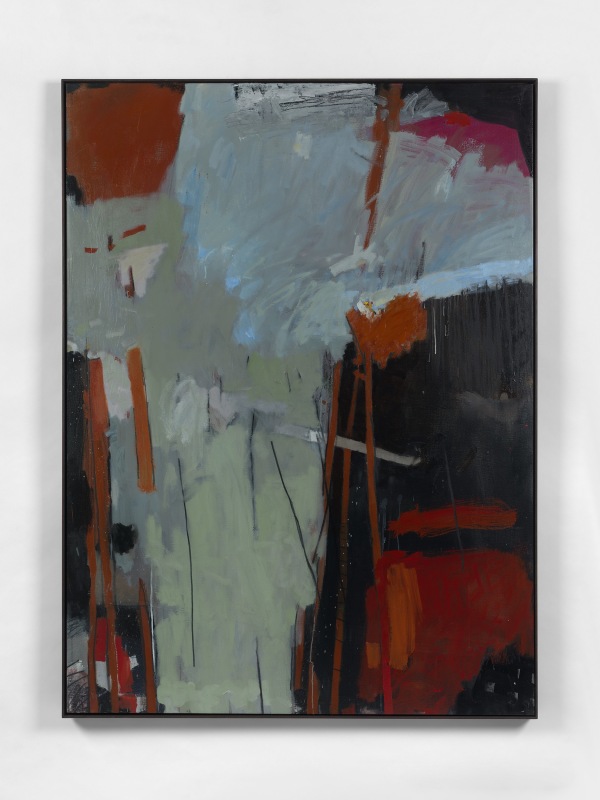Richard Hearns: Nomad
The landscape thinks itself in me, and I am its consciousness. —Paul Cézanne
Intentional and accidental marks of the artist’s hand, purposeful and irresolute expressions of gesture, vigorous and reticent swaths of paint: these are the oppositions that govern the gestural idiom of Richard Hearns, a prolific painter of abstracted landscapes. Caught up between smears of color and the intuitive representation of nature, a given painting by Hearns registers as a painterly investigation where visuality is suspended between abstraction and non-abstraction, engrossed between vision’s inherent ability to both shift and stabilize our experience of reality.
As Maurice Merleau-Ponty explains, Paul Cézanne “did not want to separate the stable things which we see and the shifting way in which they appear; he wanted to depict matter as it takes on form, the birth of order through spontaneous organization.” Rather than functioning as direct extensions of Cézanne’s vision, however, the thirteen paintings on view at Cadogan Gallery, collectively titled “Nomad” and realized in 2022, come across as continuations or reformulations of Willem de Kooning’s compositional language, a modality that itself grows out of Cézanne’s phenomenological undertaking. “Cézanne said that every brush-stroke has its own perspective … its own point of view,” de Kooning would claim.
Hearns’s “Nomad” paintings evoke such works of de Kooning as Ruth’s Zowie (1957), Black and White (1959), Door to the River (1960), and A Tree in Naples (1960), all paintings in which the motif of the landscape is as evident as it is ambiguous. Through all-over composition, speckled patches, impasto strokes, frayed edges, and figure-ground reciprocity, the “Nomad” series similarly redefines the landscape as a duality: a pictorial representation of a vast vista that is nonetheless apprehended by means of the visionary paths paved by de Kooning and Cézanne.
Through their poetic titles — Idyll, Oar, Vessel, Pilgrim, Bedouin, Icarus, Cavalcade, Wayfarer, Vinculum, Mantle, Arroyo, Link, Thole—Hearns’s paintings invite us to grasp them on their own as possible visual articulations of landscapes, as much as these paintings call forth renewed conversations with landscape’s modernity. For Hearns, the landscape embodies a mode of sensory, phenomenological perception that is itself conditioned by painting’s historical trajectories. As Merleau-Ponty noted, “the world is the vision of the world and could not be anything else.”
The ”Nomad” series exists in conversation with two earlier bodies of work by Hearns, the ”Absence” and ”Rainbow” series, both realized during Ireland’s 2020 COVID-19 lockdowns. These paintings, also on view at Cadogan gallery, bring forth the medium’s potential to address larger socio-ethical challenges. In each of his five “Absence” paintings, Hearns embeds a decidedly gestural, abstract painting within a significantly larger, blank one. This pairing brings to mind the Sartrean existential conundrum of “being and nothingness,” now shifted from its philosophical context to the artist’s self-interrogatory isolation during our global pandemic. Isolation versus connection, insularity versus unity, presence versus absence: these are a few of the dialectical allusions this enigmatic suite suggests.
In turn, we encounter a photograph of Hearns’s “Rainbow” series: seven paintings poised under a partly clear and partly cloudy sky, on the perennial ryegrass of a “museum without walls.” Against the backdrop of the Burren, a glaciokarst landscape on Ireland’s west coast, the County Clare-based photographer Eoin Collins elegantly brackets this meditative suite of paintings between the slopes of two limestone hills. The image engagingly reveals a set of formalist and conceptual exchanges between the self-contained artwork and the majesty of nature, now redirected toward the social significance of rainbows as signs of hope, solidarity, and gratitude. Emitting a luxurious continuum of hues across a celestial backdrop, Collins’s beguiling photograph of “Rainbow” ultimately reveals a poignant interweaving of sublime color and a sense of communal responsibility.
Within both of the “Absence” and “Rainbow” cycles the viewer is invited to decrypt the codes of these briskly executed paintings, interpreting them through both the historical trajectory of abstract art and the crucial prospect of expanding and redefining those historical tenets today. Both of these bodies of work, realized during an insulated voyage of self-discovery, compel the spectator to reflect upon them through intuitive associations that are nonetheless framed by the most dramatic social phenomenon of our times: a pandemic that must be countered through collective vigilance and resilience.
With brushes and rags that maneuver oil paint across the flat surface of the canvas, charcoal that delineates compositional arrangements, and occasionally tape that marks off sharp edges within the pictorial field, Hearns layers colors so as to negotiate what may lie behind, before, and upon the pigmented picture surface—within time and space. The abstracted landscapes of the “Absence,” “Rainbow,” and “Nomad” groups are capacious in their reference, whether a given series of paintings is directed toward the embodied visual experience of the Burren landscape, or toward framing that type of experience within the larger socio-ethical contexts we must all confront and address.
- Paul Cézanne, cited in Maurice Merleau-Ponty, “Cézanne’s Doubt,” in The Merleau-Ponty Aesthetics Reader: Philosophy and Painting, ed. Galen A. Johnson and Michael B. Smith (Evanston, Illinois: Northwestern University Press, 1993), p. 67.
- Merleau-Ponty, pp. 63–64.
- Willem de Kooning, interview by Harold Rosenberg, ARTnews 71 (September 1972), p. 55.
- Merleau-Ponty, The Visible and the Invisible, ed. Claude Lefort and trans. Alphonso Lingis (Evanston, Illinois: Northwestern University Press, 1968), p. 75.

